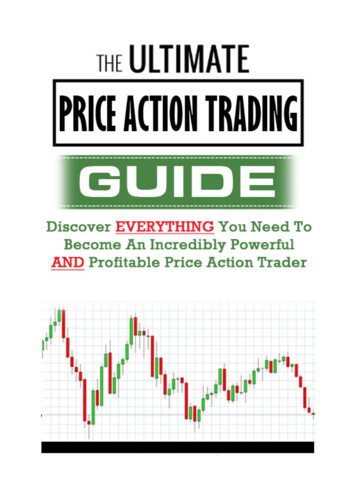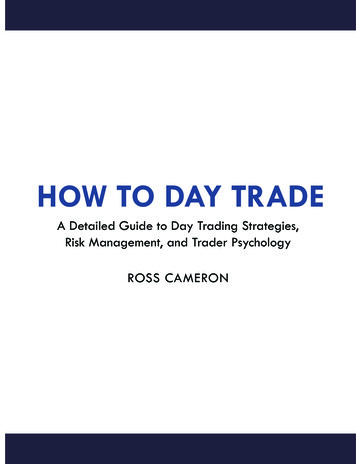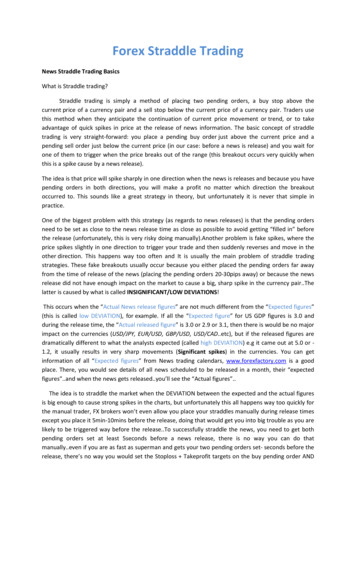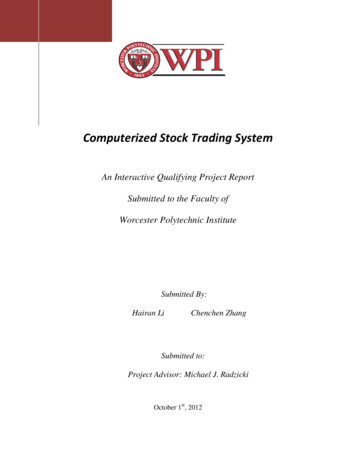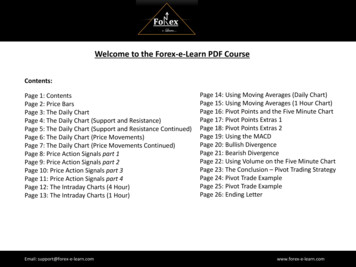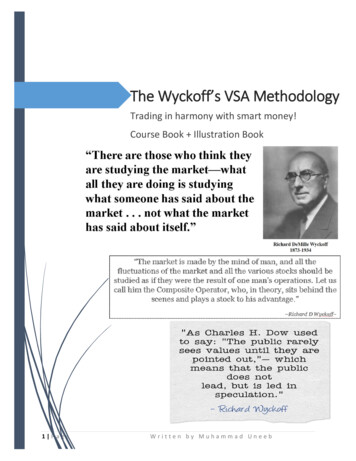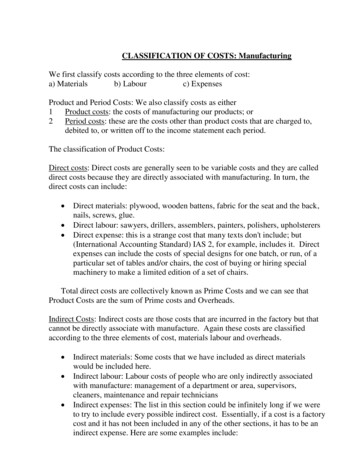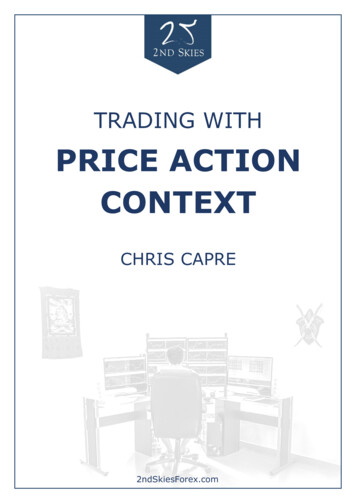
Transcription
TRADING WITHPRICE ACTIONCONTEXTCHRIS CAPRE2ndSkiesForex.com
If you think this eBook is going to be about learning a price action setup,you’re wrong. It’ll be about something much more powerful.For your future, for your learning process, and for your sanity, keepreading this eBook if you are not yet a consistently profitable trader.Of all the free articles and videos on my website, the most popular andcommented ones are always on some specific setup or system.Why?Because almost all retail traders are on a relentless hunt forthe one system, that edge which will turn your trading around.That edge which will print money into your account day after day, weekafter week without much effort.You’ve probably amassed dozens of patterns and systems, yet still aren’tmaking money.Does that sound familiar?2
If so, don’t worry – that was me 14 years ago.But I think it points to aproblem for those huntingthrough forums, websites andvideos looking for your pot ofgold.All of your focus and energyhas been on finding a‘system‘ or ‘price actionsetup‘ that makes money.But what is also going on is you want the market de-mystified.You want trading to be simple and easy, i.e. thinking a simple, easy totrade system or price action setup will solve all your trading problems andhelp you understand the market.Do you honestly think that, in a market, which has brought traders to itsknees, crying, jumping out of windows after losing fortunes, one tradesystem or price action setup plus some good money management (and alittle psychology) is all you need to be a profitable trader?If that was the case, why isn’t everyone doing it?Why are banks spending thousands of dollars, and months, if not years onend, training their traders, when there is such a conveniently packagedsolution available?Good Trading Decisions Are Based Upon ContextIf you want to find high probability trades, and skip those with a lowprobability of working out, you’ll need to develop a core skill.What is this skill you ask?The core skill we’re referring to is the ability to read ‘Price Action Context’.3
Yes, Price Action Context.Context?First, in order to make thingseasier, let’s define the word‘context’.Context understanding andapproaching a situation basedupon the ‘context’ (or environmental variables) around it.In price action, the ‘context’ is a wayof describing the overall environment, and using that to help you tradewith the underlying order flow.Price Action PyramidIf I had to look at price action as a structure, it would be a pyramid, withthe base being how price action is a reflection of order flow (particularlyexecuted transactions).In our Advanced Price Action Course, we have major 3 filters tounderstand price action context.In this eBook, we’ll only talk about 1 of these 3 filters which are impulsiveand corrective moves and forms the base of the pyramid. On the followingpages, we’ll go through the characteristics of both impulsive andcorrective moves in detail.In our Advanced Price Action Course you get access to 2more filters which are critical to be able to analyze theprice action context on any instrument and time frame.Impulsive vs.Corrective Moves4
Impulsive Moves1.orLarger candles compared to other candles in the price action,communicating the force, speed and amount of order flowduring that period of time.2.orMajority of bars are of same color, communicating that theorder flow is imbalanced more towards one side, leading to adirectional move.3.orCandles often close towards the direction of the move,communicating little or no pressure from the other side of themarket.4.In our Advanced Price Action Course we also talk about a 4thcomponent to impulsive moves which helps you to determinethe momentum/strength of such a move.During impulsive moves, the order flow is relatively ‘imbalanced’, meaningit’s dominant towards one side (buying/selling) which causes strongdirectional moves. Impulsive Move(Directional move)5
Below is an example of an impulsive move:Impulsive moves are critical to understanding price action context becausethey communicate a strong ‘imbalance’ in the order flow of the market.The more ‘imbalanced’ the order flow is to one side, the stronger thedirectional move will likely be.Impulsive moves communicate critical things to you about yourcurrent/potential trades, such as:1) Who’s in control of the market (bulls/bears)2) If a move/trend is more likely to continue3) If there is a potential breakoutAnd more By learning about impulsive moves, you can make critical tradingdecisions to increase your potential profit.6
Corrective MovesSmaller candles compared to other candles in the priceaction, communicating reduced force/speed and a greaterbalance in the order flow during applicable period of time.1.2.3.50%Candles close towards the middle, communicating lack ofconviction from both sides of the market.Greater mix of bullish/bearish candles (mixed color),communicating that the order flow is balanced (bullish andbearish order flow being equally strong) and there is no cleardirection.Corrective moves are also critical to understanding price action contextbecause they communicate a relative ‘balance’ in the order flow.If there is a relative even number of buyers and sellers (buying/selling inrelative equal amounts), the price action and market won’t move much upor down.For a directional move to happen in the markets, an ‘imbalance’ betweenthe buyers and sellers is required.BUYERSSELLERS Corrective Move(Sideways or minor directional move)7
Below is an example of a corrective move:As you can see, corrective moves are also critical to understanding priceaction context because give you important information about your tradesand price action, such as:1)2)3)4)When the market is taking a pause (likely to range)When it is more conducive to play both sides of the marketWhen you need to be more patient with your tradesPotential trade locationsAnd more Learning how to spot and read corrective moves, enables you to optimizeyour trading decisions and increase your potential profit.8
Using Impulsive and Corrective Moves to Discoverthe Price Action ContextNow that we understand the basics of impulsive and corrective moves, wecan use them to discover the price action context of the market.As a general rule, an impulsive move (the majority of the time) is followedby a corrective move.For example, a with-trend impulsive move, followed by a corrective move,is more likely to be followed by another with-trend impulsive move thanthe opposite (counter-trend).Here are two good examples showing such impulsive/correctivesequences.Example 19
Example 2“You don’t need a 1-2 bar candlestick patternto know if the market is bullish or bearish –just determine the overall ‘context’, and tradewith the impulsive and corrective structure asmuch as possible.”Now, what do impulsive and corrective moves teach us about price actioncontext?They give us an underlying sense of what the dominant order flow is.If you see a potential trend in place, along with a good series of impulsiveand corrective moves, then you can feel confident the order flow isimbalanced towards the bullish side (bullish PA context), and thus youshould be looking to buy more often than sell.10
Passive vs. Active LearningTo be sitting there passively, waiting for days on end for a specific 1-2 barcandlestick pattern to show up at the exact right location is tradingin passive mode and flat out boring.If you only can find a few setups per week, I would strongly advise you tolook into what the ability to read price action in real time can do for yourtrading.There are massive amounts of trading opportunities to be found on a dailybasis on all time frames, just waiting to be traded by you.Not only will waiting for specific 1-2 bar candlestick patterns render youpassive and bored, it will actually interfere with your learning process.Sitting on your hands, waitingpassively, is no active learning, andactive learning is what you need. Inactive learning, you are engaging yourresources, your current level ofknowledge and applying it.In passive learning, you are notengaging any of your knowledge andseeing how it works in real time,learning from the feedback loop calledthe markets.If you are sitting on the sidelines for days on end, just waiting for acandlestick pattern to form at your favorite location, you’re wasting yourtime. You could be learning, trying, studying, and participating in themarket instead, which is what facilitates learning.Bottom line is if there is a strong trend in place, why are you waiting for a specificpattern at a specific area, when the overall order flow is already bullish?11
Why are you waiting for something that may or may not materialize whenyou instead can learn to read the price action context, attack the bullishtrend, using multiple tools at your disposal which in turn lets you profitfrom the overall bullish order flow?“Get into that trend, in line with the priceaction context and make some money.”One tool we use to determine the price action context are the impulsiveand corrective moves discussed in this eBook.The most favorable situation is when you are trading in the direction ofthe impulsive moves (not against them) because you’re trading with thedominant order flow in the market. It also means you can make moneyfaster because impulsive moves travel farther and faster than correctivemoves.Hopefully, now you can see how price action context, can help you to findmore and better trade setups, increase your profit potential and at thesame time increase the quality of your learning process.Want To Learn More About Price Action Context?While impulsive and corrective moves are a crucial part to determiningprice action context, they are only one tool in the took-kit our studentsuse to achieve this.We have two other key factors to determine price action context and inwhich direction the dominant order flow in the market is imbalancedtowards.To learn more about these two, plus much more, like reversal patternsand ways to increase the accuracy of your entry locations, check outour Advanced Price Action Course, where we teach you higher-, lowerand multiple time frame context with clear rules to understanding them.In fact, our entire 1st section of lessons is dedicated specifically towardsunderstanding price action context.12
To get access to these lessons within minutes, click on Advanced PriceAction Course link on the next page.Inside the course, you’ll also learn how to read other critical (or moreadvanced) price action structures and find more trade setups.“Price action context is a skill that works on anyinstrument, time frame and in any environment.”If you’re currently learning/trading a price action strategy or approachthat only works on specific time frames or instruments, then it’s a limitedstrategy that doesn’t really understand price action or price actioncontext.If you instead want to learn how to read the markets in real time, findmore and better trade opportunities, increase your profit potential and atthe same time boost the quality of your learning process, make sure tocheck out our Advanced Price Action (APA) course here.Kind regards,Chris CapreFounder of 2ndSkiesForex13
Chris Capre’s Advanced Price Action CourseYour Complete A-Z Training on Price Action, Trading Psychology & Risk ManagementLearn the Most Important Skill - Trading Price ActionTrade On Any Instrument, Time Frame or EnvironmentIncrease Your Confidence, Discipline & ConsistencyENROLL NOWLinks to references and further study2nd Skies Forex WebsiteWebinar : Price Action ContextVideo: Price Action – Order Flow And TransitionsLive Trade ExamplesArticle: Your Brain, Trading And Finding ”The Zone”Advanced Traders Mindset Course14
Apr 02, 2018 · If you’re currently learning/trading a price action strategy or approach that only works on specific time frames or instruments, then it’s a limited strategy that doesn’t really understand price action or price action context. If you instead
